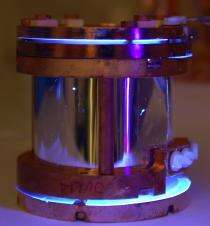September 8, 2011 report
CRESST team finds new 'evidence' of dark matter

(PhysOrg.com) -- In the never ending search for proof that dark matter really exists, new findings have emerged from a team working under a big mountain in Italy. The group, from the Max Planck Institute in Germany, have pre-published a paper on arXiv, and have also given a talk at the Topics in Astroparticle and Underground Physics conference in Munich where they describe how their CRESST II detector has recorded 67 events which they say cannot be explained by anything other than Weakly Interacting Massive Particles (WIMPS), a type of dark matter.
Dark matter is of course, at least theoretically, the stuff that holds everything in the universe together. WIMPS are thought to be a kind of dark matter that doesn’t interact much with normal matter such as the stuff that we call the Earth and everything on it. Thus, such WIMPS wouldn’t have any trouble passing through the mountain above the detector, which is comprised of bunches of tungsten held very near absolute zero. The idea being that if a WIMP were to strike the tungsten, a tiny bit of light would be given off that could be observed and recorded. Of course regular old run of the mill cosmic rays can pass through mountains as well and collide with tungsten too. But those kinds of strikes are easily discernable and thus can be discounted; hence the excitement of team and their findings.
The team using the CRESST II detector isn’t the only game in town, and the problem is, some of them aren’t able to obtain the same results. Other’s looking to discredit the whole notion of dark matter such as the CoGeNT project going on in Minnesota, wound up finding evidence of the opposite, as did the DAMA/LIBRA team, which has been running experiments for the past 12 years. Unfortunately, other teams such as XENON and CDMS II haven’t been able to find any evidence of dark matter at all.
In addition to recording the strikes on their tungsten detector, the team also recorded the amount of energy released when such collisions occur, which can be used to calculate the mass of the particle that did the striking. In this case, the team found that they weighed somewhere between 10 and 20 gigaelectronvolts, which is lighter than researchers have expected.
This new bit of evidence helps boost the idea that dark matter really does exist, though it doesn’t go far enough to prove it. As is the usual case, more science will have to be done before anything definitive can be declared.
More information: Results from 730 kg days of the CRESST-II Dark Matter Search, by G. Angloher et al., arXiv:1109.0702v1 [astro-ph.CO] arxiv.org/abs/1109.0702
Abstract
The CRESST-II cryogenic Dark Matter search, aiming at detection of WIMPs via elastic scattering off nuclei in CaWO$_4$ crystals, completed 730 kg days of data taking in 2011. We present the data collected with eight detector modules, each with a two-channel readout; one for a phonon signal and the other for coincidently produced scintillation light. The former provides a precise measure of the energy deposited by an interaction, and the ratio of scintillation light to deposited energy can be used to discriminate different types of interacting particles and thus to distinguish possible signal events from the dominant backgrounds. Sixty-seven events are found in the acceptance region where a WIMP signal in the form of low energy nuclear recoils would be expected. We estimate background contributions to this observation from four sources: 1) "leakage" from the e/gamma-band 2) "leakage" from the alpha-particle band 3) neutrons and 4) Pb-206 recoils from Po-210 decay. Using a maximum likelihood analysis, we find, at a high statistical significance, that these sources alone are not sufficient to explain the data. The addition of a signal due to scattering of relatively light WIMPs could account for this discrepancy, and we determine the associated WIMP parameters.
CRESST website: www.cresst.de/cresst.php
© 2011 PhysOrg.com



















